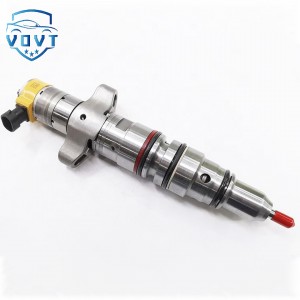New High Quality Diesel Injector 573-4231 573-4235 10R-2828 20R-1259 10R-7221 For CAT C9
Products Description
| Reference. Codes | C9 |
| Application | C9 |
| MOQ | 4PCS |
| Certification | ISO9001 |
| Place of Origin | China |
| Packaging | Neutral packing |
| Quality Control | 100% tested before shipment |
| Lead time | 7~10 working days |
| Payment | T/T, L/C, Paypal, Western Union, MoneyGram or as your requirement |
What are the cleaning methods for automobile fuel injectors?
1. Disassembly-free cleaning (suitable for daily maintenance or minor blockage)
Disassembly-free cleaning does not require disassembly of the injector. The injector is cleaned through external equipment or additives. It is easy to operate but the cleaning power is limited.
1. Bottle cleaning (disassembly-free cleaning of the fuel system)
Principle: Use special equipment (such as a fuel bottle cleaning machine) to connect the cleaning agent to the engine through the fuel pipeline, simulate the fuel injection pressure, and make the cleaning agent circulate through the injector with the "fuel" to dissolve the internal carbon deposits and impurities.
Operation steps:
Disconnect the fuel pump fuse or relay to prevent fuel from entering the pipeline (some models need to remove the fuel pump plug).
Connect the fuel delivery pipe of the cleaning machine to the fuel inlet of the engine fuel rail, and connect or block the return pipe as appropriate (some models do not have a return pipe).
Add special cleaning agents (such as injector cleaning agents, bottle special liquid) to the cleaning machine, and adjust the pressure to the same as the working pressure of the fuel system (usually 3-5bar).
Start the engine and run it at idle speed for 15-30 minutes. Turn off the engine after the cleaning agent is exhausted and restore the fuel line connection.
Advantages: No need to disassemble the parts, short time (about 1 hour), and little damage to the engine.
Disadvantages: Limited effect on severe blockage or stubborn carbon deposits, and multiple cleanings may be required.
Applicable scenarios: regular maintenance, slight carbon deposits, preventive cleaning when the vehicle mileage is 20,000-40,000 kilometers.
2. Additive cleaning (fuel treasure/injector cleaning agent)
Principle: Add special fuel additives directly to the fuel tank and enter the injector with the fuel to remove carbon deposits and colloid on the injector through chemical dissolution.
Operation steps:
Pour the additive into the fuel tank before refueling, and then fill it with fuel (add according to the proportion of the additive manual).
During driving, the additive circulates to the injector with the fuel to gradually clean the carbon deposits.
Advantages: Simple operation, no professional equipment required, suitable for daily maintenance.
Disadvantages: The cleaning effect is slow, and it needs to be used for a long time (usually 2-3 bottles need to be added continuously). It is ineffective for severe blockage.
Applicable scenarios: Prevent carbon deposits, when the vehicle mileage is short (<20,000 kilometers) or the fuel quality is poor.
2. Disassembly and cleaning (suitable for severe blockage or deep cleaning)
Disassembly and cleaning requires the injector to be removed from the engine and thoroughly cleaned with professional equipment. The cleaning is more thorough but the operation is complicated.
1. Ultrasonic cleaning
Principle: Put the injector into the ultrasonic cleaning machine, use the cavitation effect generated by high-frequency vibration to peel off the carbon deposits and impurities on the surface of the injector nozzle, and use the cleaning agent to dissolve stubborn stains.
Operation steps:
Remove the injector: disconnect the injector harness plug, remove the fuel rail fixing screws, and remove the injector (be careful to avoid damaging the sealing ring).
Preliminary cleaning: Spray the outside of the injector with a cleaning agent to remove surface oil and carbon deposits.
Ultrasonic cleaning: Place the injector in a cleaning tank filled with a special cleaning agent (such as acetone, ultrasonic cleaning fluid), set the cleaning time (usually 10-20 minutes), and turn on ultrasonic vibration.
Flow test: After cleaning, use an injector tester to detect the injection volume, spray shape and sealing to ensure that the flow of each injector is uniform (the error should be less than 5%).
Installation and reset: After cleaning, blow the injector dry with compressed air, replace the new sealing ring, and install it back to the engine as it is.
Advantages: The cleaning effect is significant, stubborn carbon deposits can be removed, and the performance of the injector can be tested at the same time.
Disadvantages: Professional tools and equipment are required, the operation takes a long time (about 2-3 hours), and the technical requirements for maintenance personnel are high.
Applicable scenarios: When the injector is severely blocked, the vehicle has obvious faults such as unstable idling and weak acceleration.
2. Manual disassembly and cleaning (simple cleaning)
Principle: Directly clean the inside of the injector by manually using tools and cleaning agents, suitable for situations where there is no professional equipment.
Operation steps:
Remove the injector (same as ultrasonic cleaning steps 1-2).
Clear the spray hole: Use a thin copper wire (smaller in diameter than the spray hole) to gently clear the spray hole of the injector, taking care to avoid damaging the inner wall of the spray hole.
Immerse and clean: Soak the injector in a chemical cleaner or special cleaning agent for 10-15 minutes, soften the carbon deposits, and then use a soft brush to clean the external and internal channels.
Rinse and dry: Rinse the inside of the injector with clean gasoline or cleaning agent, and then blow it dry with compressed air.
Installation test: After reinstalling the engine, start the vehicle to check for oil leaks or abnormal operation.
Advantages: Low cost, no special equipment required.
Disadvantages: Cleaning is not thorough enough, it is difficult to completely clean the inside of the spray hole, and the injector may be damaged.
Applicable scenarios: Emergency treatment or simple maintenance, not recommended as a regular cleaning method.
























